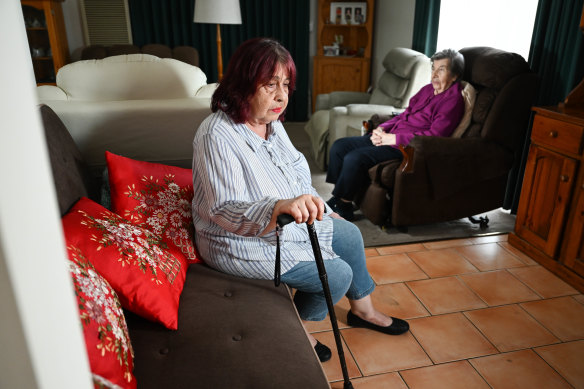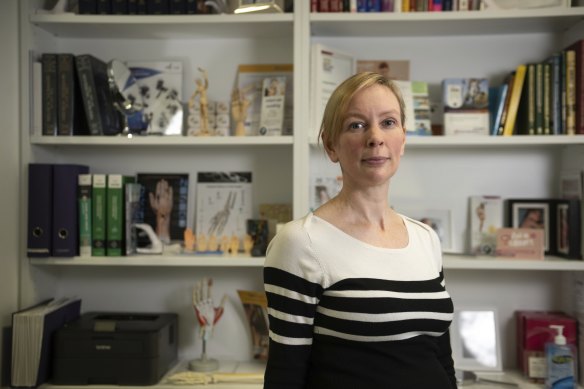- Exclusive
- Politics
- Victoria
- Healthcare
This was published 8 months ago
Victoria fell short of its lofty elective surgery promise – so it cut the target
By Kieran Rooney and Henrietta Cook
The Allan government has walked away from a promise to offer an extra 40,000 elective surgeries annually by 2024, lowering its targets back to pre-pandemic levels.
Despite Health Minister Mary-Anne Thomas once vowing she wouldn’t accept “anything less” than an ambitious goal of 240,000 surgeries a year, the state has cut the target before it was ever achieved.

Anna Peretic, who lives with her mother Franca, fell on the footpath outside a church in 2022 – and is still waiting for shoulder and hip replacement surgery.Credit: Joe Armao
Departmental performance reports contained in Tuesday’s state budget show Victoria is expected to perform 207,000 “planned surgeries” – as elective procedures are now called – by the end of this financial year. That’s 33,000 short of the standard promised.
They also reveal that for 2024-25, the system has been set a revised goal of 200,000 surgeries – on par with the pre-pandemic target in the 2019-20 budget of 203,020.
The budget papers show Victoria fell short of 240,000 surgeries due to continued pressure on health services, including “high demand for emergency surgery, workforce challenges and increased demand on emergency departments and inpatient beds”.
“The 2024-25 target is lower than the 2023-24 target to reflect the cessation of the COVID-19 catch-up plan, following significant reductions in the planned surgery waitlist,” they say.
The government’s $1.5 billion catch-up plan and reforms to surgery were launched in April 2022 ahead of a state election focused on health.
At the time, the waiting list for planned procedures was at a high of 88,000 people. It has now fallen to 62,228 – its lowest point since the pandemic.
The strategies promised to “deliver more surgery than ever before” by boosting staffing, resources and streamlining activity across the system.
“These investments will gradually build up to deliver a record 240,000 surgeries every year by 2024 – an additional 40,000 procedures annually compared to pre-pandemic levels,” according to media releases spruiking the investment.
The government maintains its programs have boosted capacity, as shown by the reduced waitlist, even though the target remains unmet. The number of people waiting for surgery can also decline through providing alternative treatments such as physiotherapy.

Health Minister Mary-Anne Thomas tours a new surgery theatre at The Alfred Centre in January.Credit: Penny Stephens
Speaking on the ABC in November 2023, six months before the targets were adjusted, Thomas said the government would not stop until it achieved 20,000 surgeries a month.
“It can be done, and we will work to deliver that 240,000 planned surgeries every year. We have a program in place in order to help us achieve that, and we will keep going until we do it,” she said.
“I can’t accept anything less than those targets on behalf of the Victorian people.”
Opposition health spokeswoman Georgie Crozier accused Labor of breaking a promise.
“These cuts to health and elective surgeries will only worsen Victoria’s ongoing health crisis and lead to longer wait times and poorer outcomes for patients,” she said.
Anna Peretic has been languishing on the planned surgery waiting list for two years and lives in excruciating pain.
The 69-year-old is deemed a category 2 patient and should have been operated on within 90 days, according to state government targets.
“I think they have given up on me,” said Peretic, who lives in Ringwood North in Melbourne’s east with her 94-year-old mother, Franca.
Peretic fell on the footpath outside a church in 2022 and has been waiting for shoulder and hip replacement surgery at her local public hospital.
She said her mother now had to care for her because she was unable to stand or walk without pain and relied on painkillers to get through the day.
“I used to enjoy cooking and going out with friends, but that has been taken away from me,” said Peretic, who relies on meal delivery kits because it hurts to stand in the kitchen and cook. “I feel useless and hopeless.”
Budget papers also show 85 per cent of non-urgent category 3 patients in Victoria are expected to be admitted within 365 days this financial year – below the target of 95 per cent.
About 70 per cent of semi-urgent category 2 patients will be treated within 90 days, below the target of 85 per cent. All urgent patients, category 1, were to be treated within 30 days.
The average wait time for a category 2 patient has fallen from 100 days to 65 since the COVID catch-up program began. Average category 3 wait times have moved from 164 days to 124.
A state government spokeswoman said its reforms had cut the surgery waiting list by 30 per cent and sped up treatment times.
“The measures we put in place during a time of crisis have worked, and it’s now time to move on from crisis mode – that’s why we provided a massive funding boost to our hospitals, giving them the certainty they need to plan for their future,” the spokeswoman said.
“Over the past two years we have reformed the way we deliver surgery – opening 10 rapid access hubs, creating two public surgical centres and establishing patient support units, and we’re on track to deliver the most surgery in Victoria’s history this year.”
Hospitals, which are increasingly reporting major operating deficits, will receive an additional $8.8 billion over the next four years.
But the budget also revealed two new hospital campuses at Arden will be relocated to Parkville because of the cost of managing electromagnetic interference from Metro Tunnel trains, and a cut of 75 per cent in funding to the Victorian Comprehensive Cancer Centre Alliance.
Dr Jill Tomlinson, Victorian president of the Australian Medical Association and a plastic reconstructive surgeon, said the targets were always ambitious and it made sense to revise them to levels that health services could handle.
“Workforce will remain a huge potential barrier to achieving the targets and, coming into winter, we also commonly see surgeries being put off because of bed capacity,” she said.

The Australian Medical Association’s Victorian president, Dr Jill Tomlinson.Credit: Penny Stephens
“The work done in surgical reform and recovery has improved efficiencies and delivered good increases in throughput, but we are yet to meet the targets.
“We need to continue to work on workforce and streamlining systems and the infrastructure required to deliver those surgical services.”
Start the day with a summary of the day’s most important and interesting stories, analysis and insights. Sign up for our Morning Edition newsletter.